What’s New with ZKs?
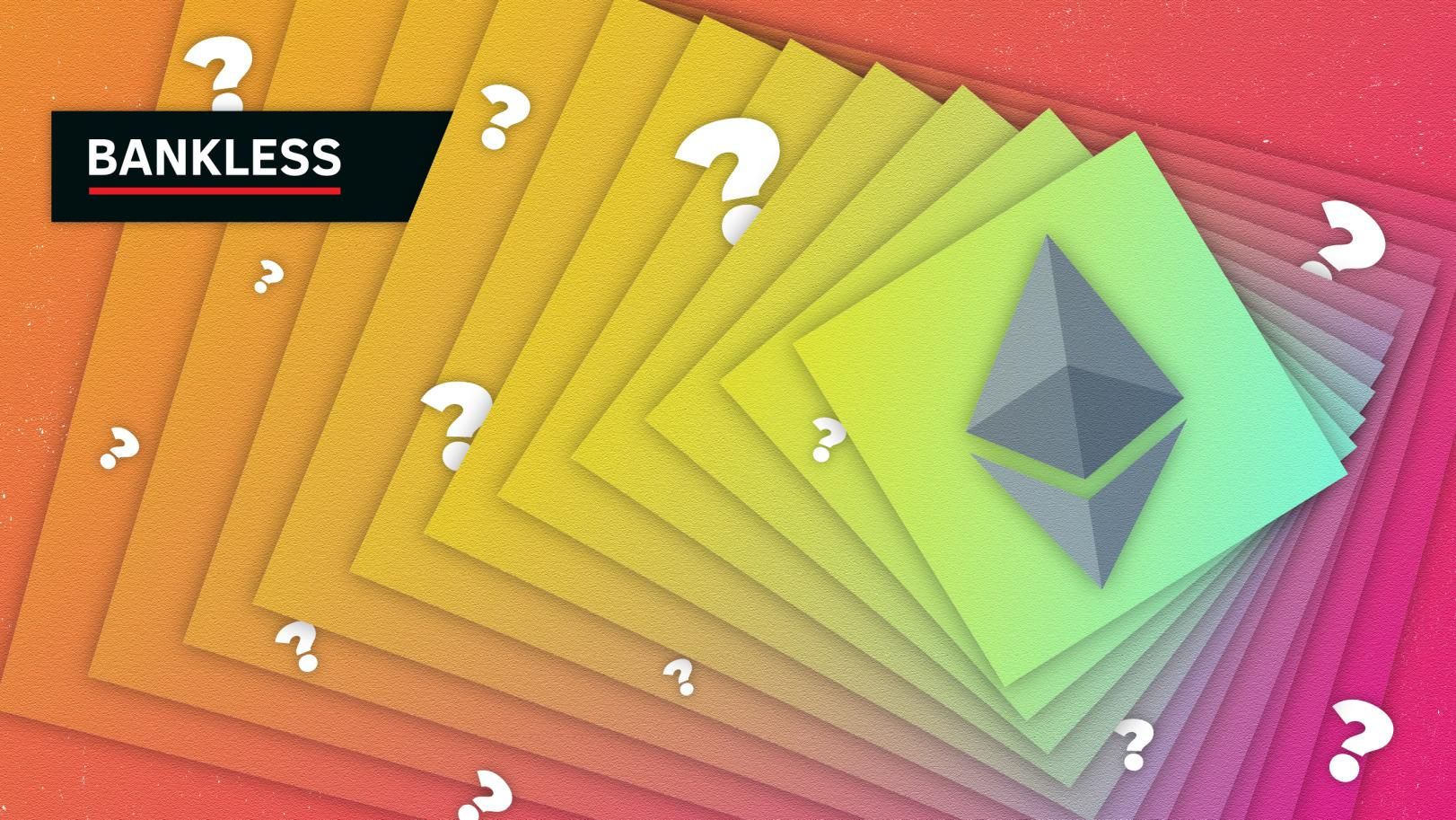
Dear Bankless Nation,
If you’re deep in the crypto world, you’ve been hearing about zero-knowledge proofs and their applications for a while now. They’re here… or they’re very close… or a certain version of them is around the corner? It’s hard to keep track.
Various implementations are out there — today we’re going through some updates on how the world of ZKs is developing.
- Bankless team
In blockchain terms, we consider the initial phase of Ethereum’s life to have been monolithic.
This means, in its first years, the “layer one” Ethereum mainnet was solely responsible for executing its own transactions, facilitating its own network security, and servicing its own data availability.
Over the past few years, Ethereum has been rapidly moving towards a modular design, meaning external third-party solutions building around Ethereum are increasingly being leaned on to scale Ethereum’s data and execution needs.
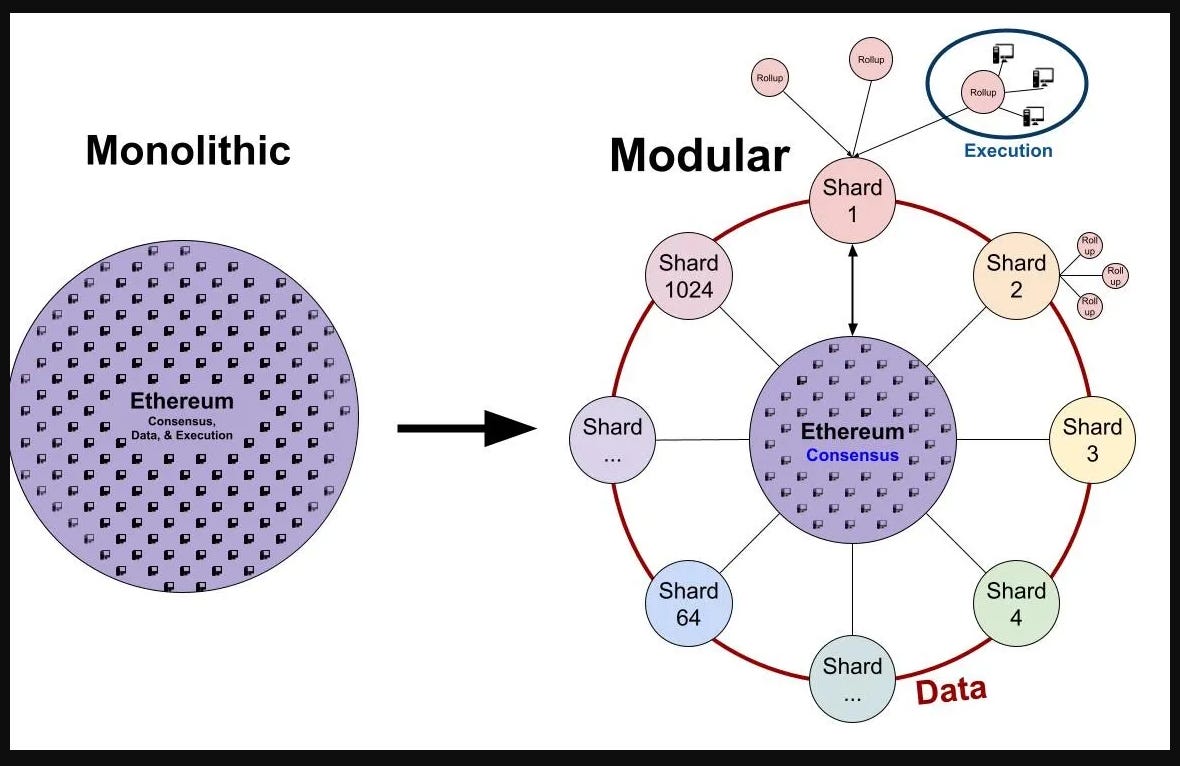
In the context of data availability, projects like Celestia and Polygon Avail are contenders. And as for execution, in recent years we’ve seen the rise of “layer two” L2s like Arbitrum and zkSync that execute transactions outside of Ethereum (i.e. offchain) and then efficiently “roll up” batches of transactions to the Ethereum L1, offering incredibly affordable and fast UX in the process.
Today, the Ethereum L1 itself facilitates a measly ~30 transactions per second (TPS). To better handle worldwide activity levels without major network congestion (high fees, slow txs), Ethereum is increasingly dependent on scaling innovations to optimize its execution capabilities. There are two main genres of solutions here: onchain scaling and offchain scaling.
Onchain scaling refers to any changes that are made directly to a blockchain in order to improve its transaction execution capabilities, namely throughput speed. For Ethereum, an example is sharding, an innovation that once implemented will spread activity loads across dozens of main, enshrined Ethereum chains instead of a singular mainnet.
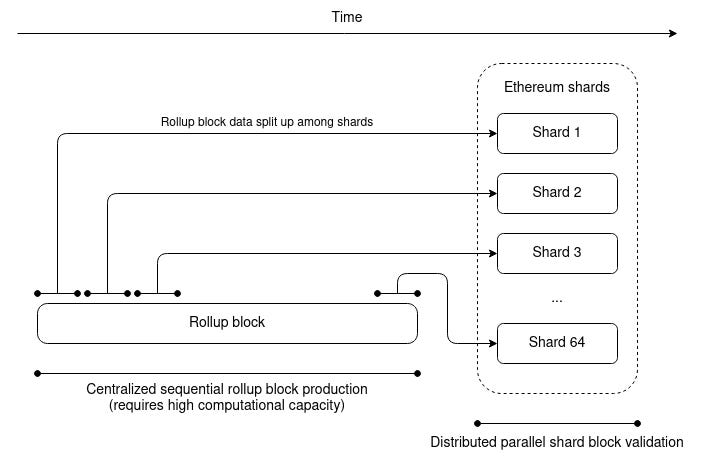
Offchain scaling refers to external execution environments, i.e., L2s that facilitate inexpensive and rapid transactions outside of Ethereum and then post transaction data in batches to Ethereum to finalize the activity and inherit Ethereum’s security. Instead of splitting the L1 into many main chains a la sharding, offchain scaling fosters a secondary layer of many external rollups that are incredibly customizable.
ZK rollups: the leading ZK-based offchain scaling tech
When it comes to L2s, among the most popular contemporary solutions are zero-knowledge rollups (ZK rollups). Notably, these rollups can facilitate around 2,000 TPS, an increase of +6,500% over Ethereum’s current 30 TPS rate!
This particular style of L2 uses “zero-knowledge proofs,” e.g. SNARKs, to cryptographically validate and post its transaction batches on Ethereum. Accordingly, combine offchain execution with onchain data via zero-knowledge proofs and you get ZK rollups (Conversely, combine offchain execution with onchain data via fraud proofs to get optimistic rollups).
All that said, the five largest ZK rollups as currently tracked by L2BEAT are as follows:
- dYdX — a crypto and derivatives exchange | $375M USD TVL
- Loopring — L2 for trading, NFTs | $121M USD TVL
- zkSync Lite — L2 for trading, NFTs | $65M USD TVL
- ZKSpace — L2 for trading, NFTs | $49M USD TVL
- Aztec Connect — L2 for private DeFI | $15M USD TVL
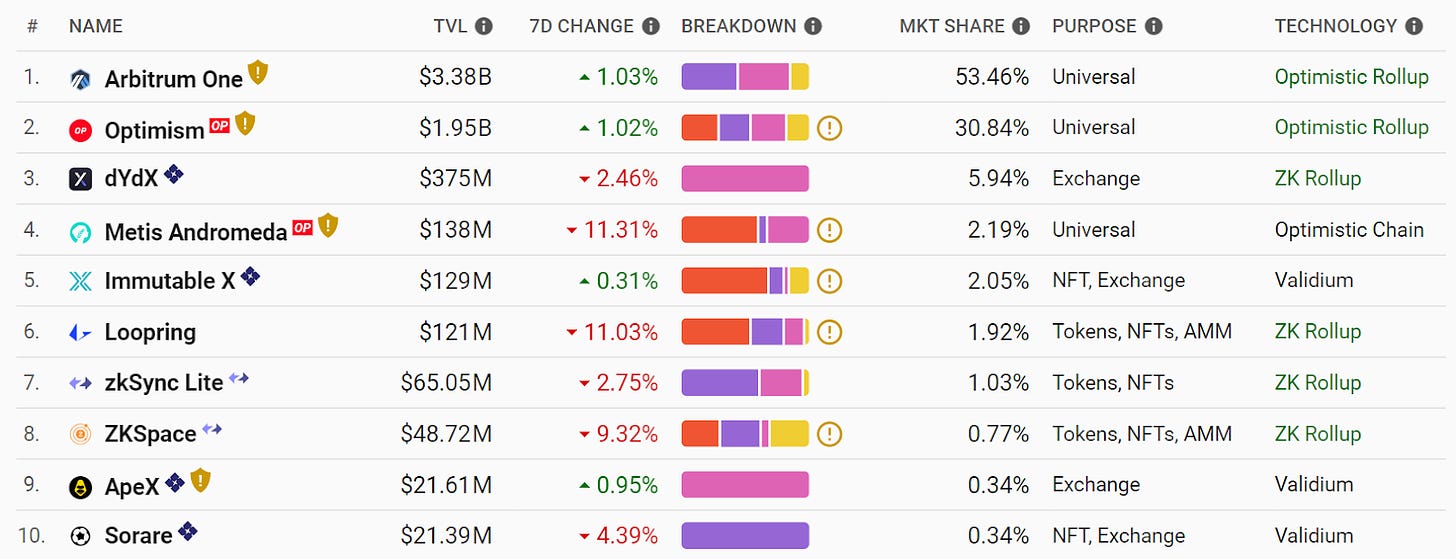
The leading ZK rollups in action today are built using StarkEx tech (e.g. dYdX and Loopring) or based on zkSync’s code (e.g. zkSync Lite and ZKSpace). However, there are more ZK rollups not linked to these tech stacks that are worth having on your radar too, like Aztec Connect.
On Validiums and Volitions
ZK rollups aren’t the only ZK-based solutions of note in the contemporary Ethereum scaling scene, however. Two other styles of scaling to note here are validiums and volitions.
Validiums execute transactions offchain and maintain their data via zero-knowledge proofs offchain, too. This approach lies in contrast to how ZK rollups batch their data onto Ethereum, i.e. posting it onchain. Where data is stored, then, is the key differentiator between ZK rollups and validiums.
The “double offchain” approach of validiums makes them ultimately custodial, since data is maintained by trusted parties. What validiums lack in trustlessness, though, they make up for in awesome performance as the most powerful ones today can facilitate +20,000 TPS.
Two of the more recognizable validiums in action right now are Immutable X, an NFT-centric scaling solution with a $123M USD TVL, and Sorare, a fantasy sports digital card game with a $21M USD TVL. Other validiums to watch presently include ApeX, rhino.fi, and Myria.
As for volitions, they’re an innovation created by the StarkWare team, and they’re a cross between a ZK-rollup and a validium. This is to say that with a volition, it’s possible for users to choose between either onchain and offchain data availability. This gives apps the option of validium-levels of TPS performance while still being interoperable with non-custodial ZK-rollup tech. zkSync’s new groundbreaking zkPorter mechanism is one such volition system to keep an eye on.
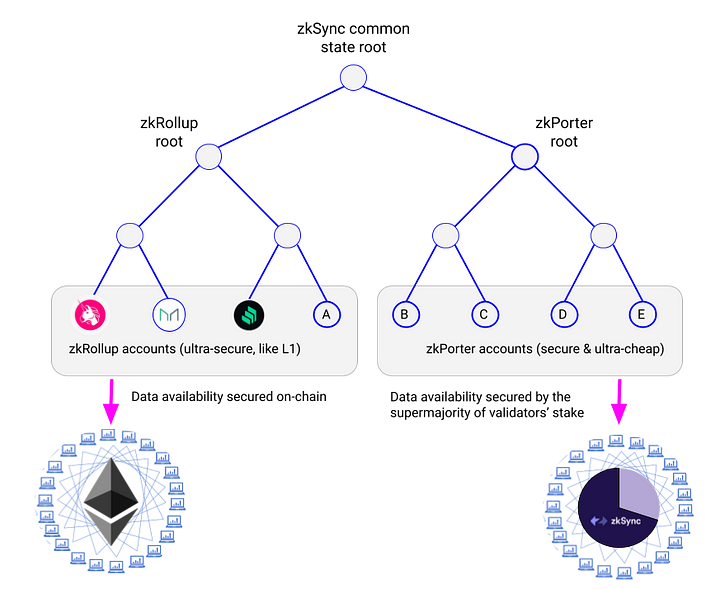
zkEVMs as scaling’s Holy Grail
Consider how the architecture of a ZK-rollup has two main components: the onchain Ethereum smart contracts that receive and track L2 block data, and the offchain virtual machine (VM) that serves as an execution environment for Ethereum-based transactions.
A zkEVM, then, is a ZK-rollup that is compatible with the Ethereum Virtual Machine (EVM), i.e. the execution environment of the Ethereum L1.
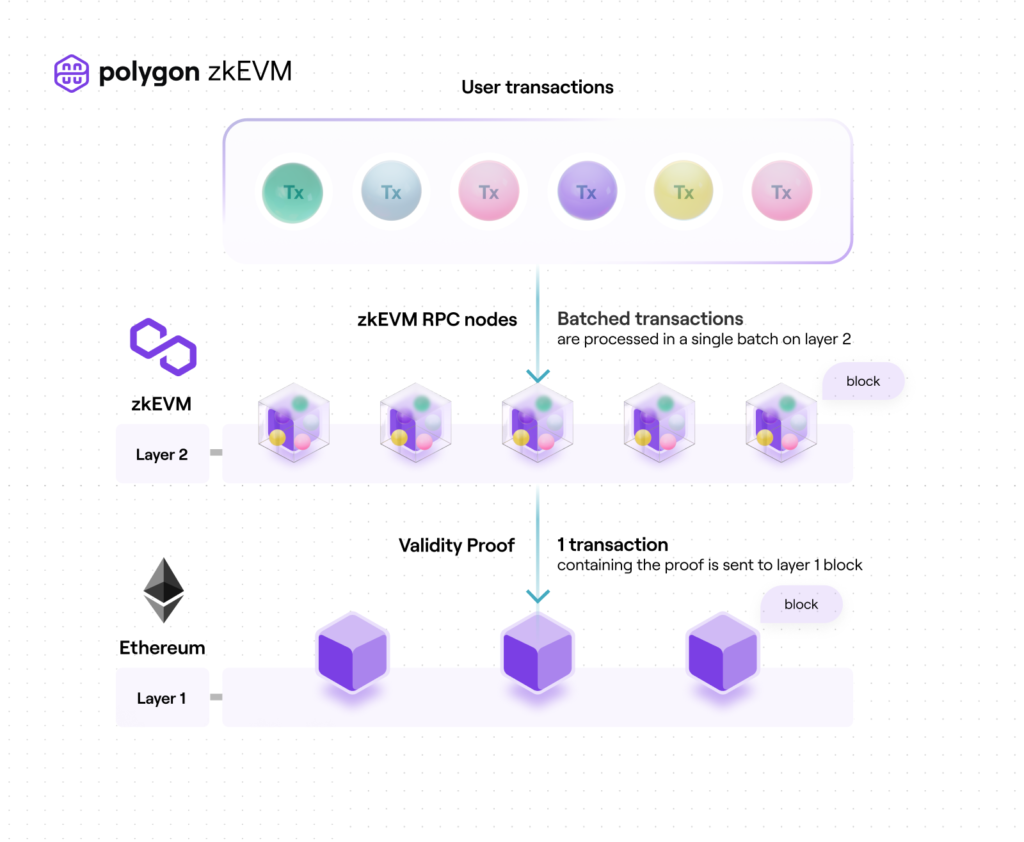
In the beginning of Ethereum’s scaling race, optimistic rollups like Arbitrum and Optimism had a huge advantage in that it was initially much easier for rollups of this style to be compatible or even fully equivalent with the EVM. This technological affinity makes it so apps can easily port over their code and use their favorite toolings from L1 to L2, which is great UX.
In contrast, the idiosyncrasies of ZK-style scaling made it so ZK rollups started out with bespoke VMs, meaning projects thereupon had the more extensive work of “interpreting” code from the EVM or using new code written from scratch. As of March 2023, though, multiple ZK rollups projects are now notably on the verge of unveiling their own zkEVM implementations!
The arrival of zkEVMs thus represents a major step toward Vitalik Buterin’s 2021 forecast that “medium to long term, ZK rollups will win out in all use cases as [the] technology improves.” ZK rollups have in-built privacy and security advantages over optimistic rollups due to their use of cryptographic proofs, so when you add EVM compatibility to the mix, ZK rollups have the potential to outcompete optimistic rollups going forward.
The ongoing race to Type 1, Type 2 zkEVMs
The “scaling wars” phrase refers to the friendly, informal rivalry taking place between optimistic rollups and ZK rollups teams to provide the best blockchain scaling solutions possible.
Yet there’s another race taking place within the ZK rollups sector itself, and it’s an informal competition to see which team can achieve the first “Type 1” and “Type 2” zkEVMs as defined by Vitalik Buterin.

In an August 2022 blog post, Buterin provided a way to gauge the capabilities of zkEVM projects by putting forth a scale from Type 1 to Type 4 to grade them along. A Type 1 zkEVM would be fully equivalent with the EVM and could even be used to upgrade Ethereum itself, while a Type 4 zkEVM would only be compatible with some Ethereum apps.
That said, it will still be some time before a Type 1 zkEVM materializes because of all the work involved, but multiple projects are honing in on Type 2 zkEVMs right now.
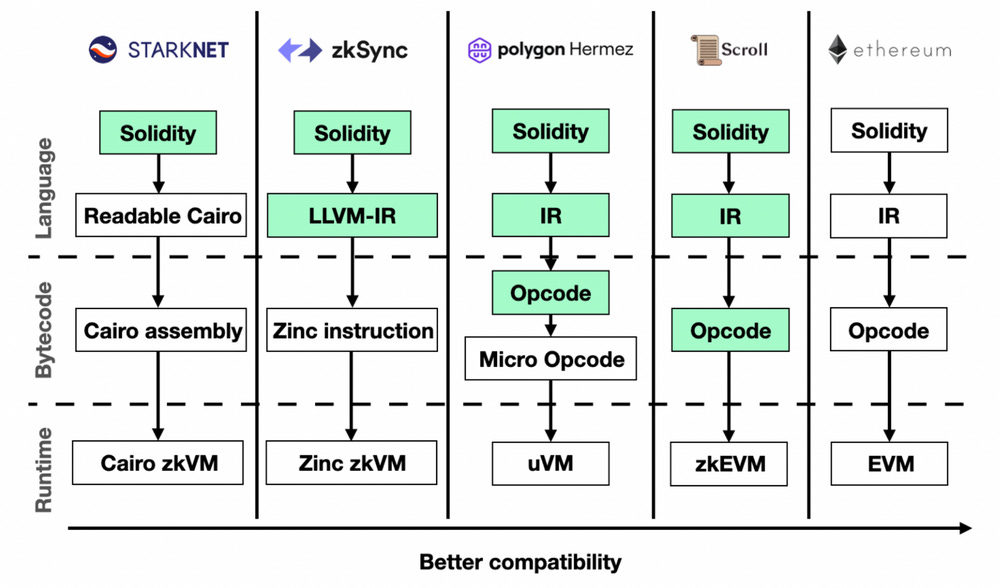
For example, the Polygon zkEVM is a Type 3 zkEVM and is in the process of becoming a Type 2 zkEVM, i.e. EVM-equivalent with a few additional nuances. Scroll is another notable team presently building toward a Type 2 zkEVM. In contrast, zkSync Era (formerly zkSync 2.0) is an opinionated, intentional Type 4 zkEVM that is enhanced with custom features and zkPorter’s impressive volition capabilities. The spectrum of possibilities here is wide open accordingly.
The latest on zkEVM progress to date
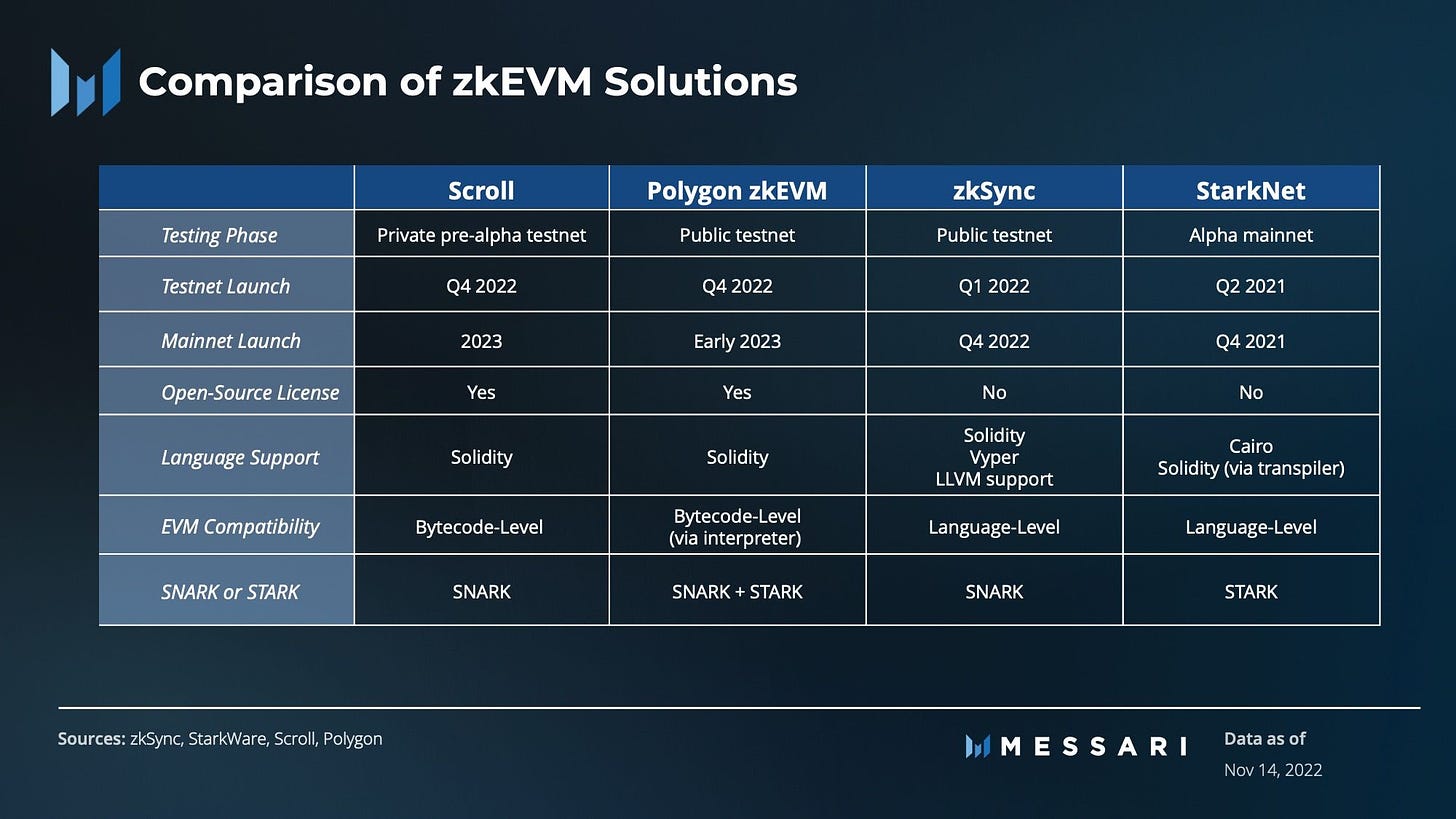
🟣 The Polygon zkEVM mainnet beta begins on March 27th:
Roses are red 🌹
— Polygon (@0xPolygon) February 14, 2023
Violets are blue
Poems are hard 😩
Mainnet Beta is here
ON MARCH 27, Polygon #zkEVM launches the future of Ethereum scaling
🚢💜🚢💜https://t.co/OqSOYTn8Uv pic.twitter.com/kpXavea3ff
🔁 zkSync Era just launched its mainnet to builders, users coming soon:
The wait is over.
— zkSync ∎ (@zksync) February 16, 2023
All aboard zkSync Era∎ Mainnet!
Today, Ethereum's first zkEVM is:
• Opening mainnet to builders 🥳
• Adopting a brand new name 🎈
• Open-sourcing its entire codebase 🎆https://t.co/PoZeliPU8t
1/8
📜 Scroll just released its Goerli zkEVM testnet, the final step before mainnet:
For nearly two years, we've built our zkEVM in the open alongside @PrivacyScaling and other contributors, and today, we're taking the next step to Goerli, the final stage before mainnet.
— Scroll 📜 (@Scroll_ZKP) February 27, 2023
Our testnet on Goerli is 100% permissionless.
Here are the details:
🌐 StarkNet’s Kakarot zkEVM is already at Type 3 status and climbing:
And we dit it! 100% EVM opcodes compatibility on @KakarotZkEvm !https://t.co/me5g9t1tsk
— abdel.stark ✨ 🐺 - 🦇🔊 (@dimahledba) December 23, 2022
In 2 months and 20 days...
No funding, no company, only a community of passionate builders ❤️
I am so thrilled. Still a long way to go before running into production but this is amazing 🔥 pic.twitter.com/4iILB0uWml
The dawn of a new blockchain UX era
One day, Ethereum itself may upgrade to a Type 1 zkEVM for further onchain scaling. In the meantime and complementary to that potential upgrade, external zkEVMs from Type 2s to Type 4s will continue to blossom and provide unique customizations and UX enhancements, both for devs and users, that the Ethereum L1 cannot.
All in all, then, the endgame for the ZK rollups space (and arguably the L2 space in altogether) is zkEVMs, and the first of these efforts are on the verge of showtime. 2023 will be the year that everyday crypto users will be able to try zkEVMs for the first time, so keep your eyes peeled on Polygon, zkSync, StarkNet, and Scroll if you want to hop in as these teams’ latest scaling advancements come into action!